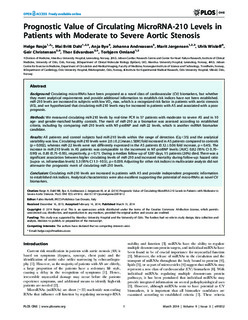| dc.contributor.author | Røsjø, Helge | |
| dc.contributor.author | Dahl, Mai Britt | |
| dc.contributor.author | Bye, Anja | |
| dc.contributor.author | Andreassen, Johanna | |
| dc.contributor.author | Jørgensen, Marit | |
| dc.contributor.author | Wisløff, Ulrik | |
| dc.contributor.author | Christensen, Geir Arve | |
| dc.contributor.author | Edvardsen, Thor | |
| dc.contributor.author | Omland, Torbjørn | |
| dc.date.accessioned | 2015-11-24T09:34:51Z | |
| dc.date.accessioned | 2015-12-09T14:29:00Z | |
| dc.date.available | 2015-11-24T09:34:51Z | |
| dc.date.available | 2015-12-09T14:29:00Z | |
| dc.date.issued | 2014 | |
| dc.identifier.citation | PLoS ONE 2014, 9(3) | nb_NO |
| dc.identifier.issn | 1932-6203 | |
| dc.identifier.uri | http://hdl.handle.net/11250/2367374 | |
| dc.description.abstract | Background:
Circulating micro-RNAs have been proposed as a novel class of cardiovascular (CV) biomarkers, but whether they meet analytical requirements and provide additional information to establish risk indices have not been established. miR-210 levels are increased in subjects with low VO2 max, which is a recognized risk factor in patients with aortic stenosis (AS), and we hypothesized that circulating miR-210 levels may be increased in patients with AS and associated with a poor prognosis.
Methods:
We measured circulating miR-210 levels by real-time PCR in 57 patients with moderate to severe AS and in 10 age- and gender-matched healthy controls. The merit of miR-210 as a biomarker was assessed according to established criteria, including by comparing miR-210 levels with NT-proBNP and miR-22 levels, which is another miRNA biomarker candidate.
Results:
All patients and control subjects had miR-210 levels within the range of detection (Cq<35) and the analytical variability was low. Circulating miR-210 levels were 2.0±0.2 [mean±SEM] fold increased in AS patients compared to controls (p = 0.002), whereas miR-22 levels were not differently expressed in the AS patients (0.12±0.06 fold increase, p = 0.45). The increase in miR-210 levels in AS patients was comparable to the increment in NT-proBNP levels: [AUC] 0.82 (95% CI 0.70–0.90) vs. 0.85 (0.75–0.93), respectively, p = 0.71. During a median follow-up of 1287 days, 15 patients (26%) died. There was a significant association between higher circulating levels of miR-210 and increased mortality during follow-up: hazard ratio [supra- vs. inframedian levels] 3.3 (95% CI 1.1–10.5), p = 0.039. Adjusting for other risk indices in multivariate analysis did not attenuate the prognostic merit of circulating miR-210 levels.
Conclusion:
Circulating miR-210 levels are increased in patients with AS and provide independent prognostic information to established risk indices. Analytical characteristics were also excellent supporting the potential of micro-RNAs as novel CV biomarkers. | nb_NO |
| dc.language.iso | eng | nb_NO |
| dc.publisher | Public Library of Science | nb_NO |
| dc.title | Prognostic value of circulating microRNA-210 levels in patients with moderate to severe aortic stenosis | nb_NO |
| dc.type | Journal article | nb_NO |
| dc.type | Peer reviewed | en_GB |
| dc.date.updated | 2015-11-24T09:34:51Z | |
| dc.source.volume | 9 | nb_NO |
| dc.source.journal | PLoS ONE | nb_NO |
| dc.source.issue | 3 | nb_NO |
| dc.identifier.doi | 10.1371/journal.pone.0091812 | |
| dc.identifier.cristin | 1166683 | |
| dc.description.localcode | © 2014 Røsjø et al. This is an open-access article distributed under the terms of the Creative Commons Attribution License, which permits unrestricted use, distribution, and reproduction in any medium, provided the original author and source are credited. | nb_NO |
